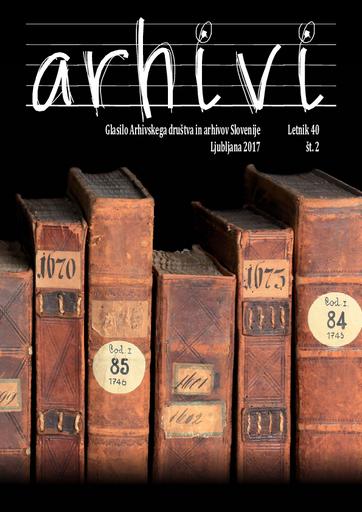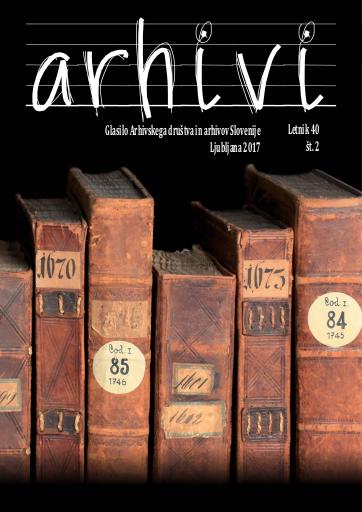/
Serijske publikacije
/
Arhivi
Usoda slovenskih orgel v prvi svetovni vojni


To delo avtorja Jurij Dobravec je ponujeno pod Creative Commons Priznanje avtorstva-Nekomercialno-Deljenje pod enakimi pogoji 4.0 Mednarodna
Datoteke (1)

Opis
V prispevku osvetljujem dogajanje leta 1917, ko je takratna oblast avstro-ogrske monarhije za vojaške potrebe zbirala predmete iz barvnih kovin. Osredotočam se na odvzem kovinskih orgelskih piščali, zaradi katerega so nekatere orgle še po 100 letih v nerabnem stanju, spomin pa je obeležen na slovenskem bankovcu za 200 tolarjev. Arhivi o odvzemu hranijo obširno dokumentacijo, vendar je ta razpršena po različnih ustanovah in danes po več državah. Rezultati so pokazali, da je bil odnos do orgelske dediščine v takratnih slovenskih in okoliških deželah različen, kar ima za posledico značilno različno stopnjo ohranjenosti starih glasbil po slovenskih pokrajinah. V razpravi skušam s pomočjo dostopnih dokumentov najti razloge za različna ravnanja in različno stanje. Kot sklepno ugotovitev poudarjam nujnost širokega pogleda, objektivnih argumentov in kakovostne strategije, ki so za ohranjanje kulturne dediščine pomembni predvsem v kriznih časih.
Metapodatki (12)
- identifikatorhttps://hdl.handle.net/11686/41556
- naslov
- Usoda slovenskih orgel v prvi svetovni vojni
- The Destiny of Slovenian Pipe Organs in the First World War
- avtor
- Jurij Dobravec
- soavtor
- Gregor Jenuš (gl. in odg. ur.)
- Dunja Mušič (teh. ur.)
- Petra Markuš (prev.)
- Tanja Martelanc (foto.)
- predmet
- IZ ARHIVSKIH FONDOV IN ZBIRK
- orgle
- prva svetovna vojna
- odvzem kovin
- kulturna dediščina
- strateško načrtovanje
- FROM THE ARCHIVAL FILES AND COLLECTIONS
- Pipe organ
- First World War
- metals confiscation
- strategic planning
- opis
- Periods of crisis represent important milestones for cultural heritage. War is an extreme situation, but upon uncertain circumstances actions can be unpredictable even during a peaceful period. Even legislation that seems perfect could turn out ineffective in practice – particularly in the absence of resources or people. Thus organs around Europe, for example, are experiencing an existential crisis. Since those are mainly church musical instruments and the number of churchgoers and believers is steadily diminishing, we wonder who will listen to organs in the future, or even look at them. The church is undergoing reorganization, some formerly significant church buildings in the country are losing their purpose. In 2017, 93 churches of Diocese of Koper changed their status of parish church into that of a subordinate branch. In the short term, the economic changes cannot be expected, while the use of organs will undoubtedly decrease to a level of present subsidiary churches. Cathedral buildings in Western European metropolitan areas are being sold and will be intended for secular use not necessarily restricted to culture. The modern way of life is becoming less fond of live classical music where organs represent very narrow and strongly specialized segment. Alternative solutions with multimedia and similar organ performances generally prove ineffective. Abandonement is guaranteed not to justify substantial funding of thereto heritage. Increasing nonexpert interference with organs, despite good intentions for their usefulness, cause irreparable damage. Today we have reliable and well-compiled data about organs. The situation shows that at least 34 organs in Slovenia are placed in few or inappropriate warehouses. It is recorded that currently 130 abandoned instruments stand on choirs. The majority is older than 100 years which means that, according to the Cultural Heritage Protection Act, they are classified as national treasure. At least 50 musical instruments are baroque, therefore originating from before 1750, among those is the Steinhofer’s organ in Mekinje from 1720 that graced the cover of Orgle na Slovenskem, and renowned positive from Strmca (in the municipality of Laško) from mid-17th century, acknowledged as one of the oldest preserved and still usable instruments in our land. Archival documents speak of facts, events, however, speak of decisions which have shortterm or long-term consequences. For the circumstances during the First World War, it is understandable that decisions proved to be very difficult. Regarding the heritage, a distinction must be drawn between the situation at the front and the circumstances in the hinterland at the time. This contribution primarily covers hinterland. Authorities definitely had data on organs. It seems that emotional charge was in some cases stronger than proper and informed judgment and decisions that were then offered by military laws. The consequences are still being felt today. Although we do not expect a war, similar crises can arise from other reasons. Qualitative data and good and coordinated strategy with pre-established and clearly defined priorities are essential for accountable decision-making.
- založnik
- Arhivsko društvo Slovenije
- datum
- 2017
- 01. 01. 2017
- tip
- besedilo
- jezik
- Slovenščina
- jeDelOd
- pravice
- licenca: ccByNcSa
